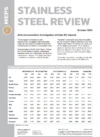Stainless steel prices forecast to commence gradual recovery
The coronavirus outbreak has severely affected the global stainless steel sector. Although end-user manufacturing facilities are gradually resuming operations, activity levels continue to be considerably below those witnessed pre-Covid-19. Mill sales volumes to customers in several steel-consuming sectors, most notably the automotive segment, remain subdued.
Service centres and traders are attempting to sell as much material as possible from their existing stock, rather than placing orders for new production. Therefore, steelmakers around the world are operating at reduced levels of output. Consequently, most producers are purchasing smaller volumes of steelmaking ingredients.
Raw material cost hikes
Despite lower demand throughout the stainless steel supply chain, the lockdown restrictions resulted in an increase in raw material costs. The LME monthly average cash nickel price increased by more than 3 percent, in May. Reduced availability of nickel ore, from Indonesia and the Philippines, is likely to result in primary nickel values moving upwards, in the short term. However, the increases will be moderated by muted demand and elevated LME stock levels.
Molybdenum selling values were volatile, in May. Output cuts at mines in China and the US helped to lift prices, later in the month. Further rises are predicted, in the short term. Spot chromium values also increased, recently, due to restricted supply – particularly, from South Africa. Additional advances in selling figures are envisaged.
Whilst market prices for alloying elements are still used in the calculation of stainless steel surcharges, in both Europe and North America, steelmakers’ input costs are heavily influenced by the value of stainless scrap. Coronavirus-related manufacturing shutdowns led to a reduction in scrap generation. Consequently, prices, for certain grades of the raw material, strengthened, in May. Market participants report that whilst availability is tight, it is sufficient for the current level of mill output. Nevertheless, an increase in stainless steel production, without an equivalent rise in scrap generation, would support further price rises in the coming months.
Price revival to extend into 2021
Stainless steel producers announced increased alloy surcharges for June, in Europe and North America, due to rising mill input costs. However, demand for stainless steel is expected to remain weak. Many buyers will continue to delay making new purchases. Steelmakers are likely to maintain reduced levels of output. Therefore, a reduction in European effective prices is envisaged, this month.
The full increase in alloy surcharges is expected to be implemented in North America. However, the mills are likely to be willing to negotiate deals for substantial order volumes. In Asia, a strengthening in stainless steel prices is anticipated, in the short term. Nonetheless, the level of increase will be restricted by subdued demand from both home and export markets.
MEPS predicts a cost-based upturn in global stainless steel prices during the second half of 2020. The recovery, in demand and transaction values, is forecast to extend into 2021.

Source:
Stainless Steel Review
The MEPS Stainless Steel Review is an invaluable monthly guide to international stainless steel prices and includes the latest global stainless steel industry analysis.
Go to productRequest a free publication





